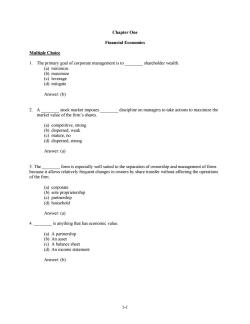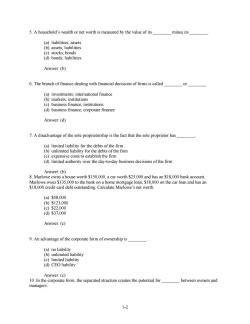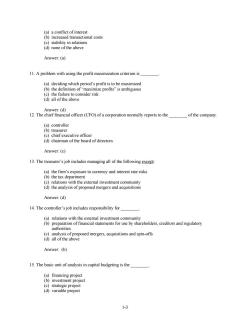上海交通大学:《金融学原理》课程教学资源(练习与答案)Chapter One Financial Economics

Chapter One Financial Economics Multiple Choice 1.The primary goal of corporate management is to shareholder wealth. (a)minimize (b)maximize (c)leverage (d)mitigate Answer:(b) 2.A stock market imposes discipline on managers to take actions to maximize the market value of the firm's shares (a)competitive,strong (b)dispersed,weak (c)mature,no (d)dispersed,strong Answer:(a) 3.The form is especially well suited to the separation of ownership and management of firms because it allows relatively frequent changes in owners by share transfer without affecting the operations of the firm. (a)corporate (b)sole proprietorship (c)partnership (d)household Answer:(a) 4. is anything that has economic value. (a)A partnership (b)An asset (c)A balance sheet (d)An income statement Answer:(b) 1-1
1-1 Chapter One Financial Economics Multiple Choice 1. The primary goal of corporate management is to ________ shareholder wealth. (a) minimize (b) maximize (c) leverage (d) mitigate Answer: (b) 2. A ________ stock market imposes ________ discipline on managers to take actions to maximize the market value of the firm’s shares. (a) competitive, strong (b) dispersed, weak (c) mature, no (d) dispersed, strong Answer: (a) 3. The ________ form is especially well suited to the separation of ownership and management of firms because it allows relatively frequent changes in owners by share transfer without affecting the operations of the firm. (a) corporate (b) sole proprietorship (c) partnership (d) household Answer: (a) 4. ________ is anything that has economic value. (a) A partnership (b) An asset (c) A balance sheet (d) An income statement Answer: (b)

5.A household's wealth or net worth is measured by the value of its minus its (a)liabilities;assets (b)assets;liabilities (c)stocks;bonds (d)bonds;liabilities Answer:(b) 6.The branch of finance dealing with financial decisions of firms is called or (a)investments;international finance (b)markets;institutions (c)business finance;institutions (d)business finance;corporate finance Answer:(d) 7.A disadvantage of the sole proprietorship is the fact that the sole proprietor has (a)limited liability for the debts of the firm (b)unlimited liability for the debts of the firm (c)expensive costs to establish the firm (d)limited authority over the day-to-day business decisions of the firm Answer:(b) 8.Marlowe owns a house worth $150,000,a car worth $25,000 and has an $18,000 bank account. Marlowe owes $135,000 to the bank on a home mortgage loan,$18,000 on the car loan and has an $18,000 credit card debt outstanding.Calculate Marlowe's net worth. (a)$58,000 (b)$123,000 (c)$22,000 (d)$37,000 Answer:(c) 9.An advantage of the corporate form of ownership is (a)no liability (b)unlimited liability (c)limited liability (d)CEO liability Answer:(c) 10.In the corporate form,the separated structure creates the potential for between owners and managers. 1-2
1-2 5. A household’s wealth or net worth is measured by the value of its ________ minus its ________. (a) liabilities; assets (b) assets; liabilities (c) stocks; bonds (d) bonds; liabilities Answer: (b) 6. The branch of finance dealing with financial decisions of firms is called ________ or ________. (a) investments; international finance (b) markets; institutions (c) business finance; institutions (d) business finance; corporate finance Answer: (d) 7. A disadvantage of the sole proprietorship is the fact that the sole proprietor has ________. (a) limited liability for the debts of the firm (b) unlimited liability for the debts of the firm (c) expensive costs to establish the firm (d) limited authority over the day-to-day business decisions of the firm Answer: (b) 8. Marlowe owns a house worth $150,000, a car worth $25,000 and has an $18,000 bank account. Marlowe owes $135,000 to the bank on a home mortgage loan, $18,000 on the car loan and has an $18,000 credit card debt outstanding. Calculate Marlowe’s net worth. (a) $58,000 (b) $123,000 (c) $22,000 (d) $37,000 Answer: (c) 9. An advantage of the corporate form of ownership is ________. (a) no liability (b) unlimited liability (c) limited liability (d) CEO liability Answer: (c) 10. In the corporate form, the separated structure creates the potential for ________ between owners and managers

(a)a conflict of interest (b)increased transactional costs (c)stability in relations (d)none of the above Answer:(a) 11.A problem with using the profit maximization criterion is (a)deciding which period's profit is to be maximized (b)the definition of"maximize profits"is ambiguous (c)the failure to consider risk (d)all of the above Answer:(d) 12.The chief financial officer(CFO)of a corporation normally reports to the of the company. (a)controller (b)treasurer (c)chief executive officer (d)chairman of the board of directors Answer:(c) 13.The treasurer's job includes managing all of the following except: (a)the firm's exposure to currency and interest rate risks (b)the tax department (c)relations with the external investment community (d)the analysis of proposed mergers and acquisitions Answer:(d) 14.The controller's job includes responsibility for (a)relations with the external investment community (b)preparation of financial statements for use by shareholders,creditors and regulatory authorities (c)analysis of proposed mergers,acquisitions and spin-offs (d)all of the above Answer:(b) 15.The basic unit of analysis in capital budgeting is the (a)financing project (b)investment project (c)strategic project (d)variable project 1-3
1-3 (a) a conflict of interest (b) increased transactional costs (c) stability in relations (d) none of the above Answer: (a) 11. A problem with using the profit maximization criterion is ________. (a) deciding which period’s profit is to be maximized (b) the definition of “maximize profits” is ambiguous (c) the failure to consider risk (d) all of the above Answer: (d) 12. The chief financial officer (CFO) of a corporation normally reports to the ________ of the company. (a) controller (b) treasurer (c) chief executive officer (d) chairman of the board of directors Answer: (c) 13. The treasurer’s job includes managing all of the following except: (a) the firm’s exposure to currency and interest rate risks (b) the tax department (c) relations with the external investment community (d) the analysis of proposed mergers and acquisitions Answer: (d) 14. The controller’s job includes responsibility for ________. (a) relations with the external investment community (b) preparation of financial statements for use by shareholders, creditors and regulatory authorities (c) analysis of proposed mergers, acquisitions and spin-offs (d) all of the above Answer: (b) 15. The basic unit of analysis in capital budgeting is the ________. (a) financing project (b) investment project (c) strategic project (d) variable project

Answer:(b) 16.The basic unit of analysis in capital structure decisions is the (a)firm as a whole (b)investment project (c)firm's personnel (d)financial system Answer:(a) Short Problems 1.Give a brief description of the wide range of financial instruments and claims a firm can issue. Answer:These include common stock,preferred stock,bonds and convertible securities (standardized securities that can be traded in organized markets).Financial instruments and claims can also include nonmarketable claims such as bank loans,employee stock options,leases and pension liabilities. 2.Siggy owns a house worth $200,000,a car worth $25,000 and has an $18,000 bank account.He also has furniture worth $4,000 and jewelry worth $10,000.However,Siggy owes $145,000 to the bank on a home mortgage loan,$17,000 on the car loan,$40,000 on student loans and has an $16,000 credit card debt outstanding.Calculate Siggy's net worth. Answer:Net Worth Total Assets-Total Liabilities = S200,000+S25,000+S18,000+S4,000+$10,000)- S145,000+S17,000+S40,000+816,000) =S39.000 Longer Problems 1.Describe the four basic types of financial decisions faced by householders Answer:Investment decisions-whether to invest in stocks or bonds Consumption/Savings Decisions-how much to save for one's retirement or a child's education Risk management decisions-whether to buy disability insurance Financing decisions-what type of loan to adopt in order to finance the purchase of a home or car. 2. Discuss the types of decisions that firms must make. Answer:Capital budgeting decisions-whether to build a new plant or produce a new product. Financing decisions-how much equity and how much debt a firm should adopt in its capital structure. Working Capital decisions-whether credit should be extended to a customer or cash demanded on delivery. 1-4
1-4 Answer: (b) 16. The basic unit of analysis in capital structure decisions is the ________. (a) firm as a whole (b) investment project (c) firm’s personnel (d) financial system Answer: (a) Short Problems 1. Give a brief description of the wide range of financial instruments and claims a firm can issue. Answer: These include common stock, preferred stock, bonds and convertible securities (standardized securities that can be traded in organized markets). Financial instruments and claims can also include nonmarketable claims such as bank loans, employee stock options, leases and pension liabilities. 2. Siggy owns a house worth $200,000, a car worth $25,000 and has an $18,000 bank account. He also has furniture worth $4,000 and jewelry worth $10,000. However, Siggy owes $145,000 to the bank on a home mortgage loan, $17,000 on the car loan, $40,000 on student loans and has an $16,000 credit card debt outstanding. Calculate Siggy’s net worth. Answer: Net Worth = Total Assets – Total Liabilities = ($200,000 + $25,000 + $18,000 + $4,000 + $10,000) – ($145,000 + $17,000 + $40,000 + $16,000) = $39,000 Longer Problems 1. Describe the four basic types of financial decisions faced by householders. Answer: Investment decisions – whether to invest in stocks or bonds Consumption/Savings Decisions – how much to save for one’s retirement or a child’s education Risk management decisions – whether to buy disability insurance Financing decisions – what type of loan to adopt in order to finance the purchase of a home or car. 2. Discuss the types of decisions that firms must make. Answer: Capital budgeting decisions – whether to build a new plant or produce a new product. Financing decisions – how much equity and how much debt a firm should adopt in its capital structure. Working Capital decisions – whether credit should be extended to a customer or cash demanded on delivery
按次数下载不扣除下载券;
注册用户24小时内重复下载只扣除一次;
顺序:VIP每日次数-->可用次数-->下载券;
- 上海交通大学:《国际政治经济学的源与流》选修课程PPT教学课件_自由主义.ppt
- 上海交通大学:《国际政治经济学的源与流》选修课程PPT教学课件_课程简介与绪论(陈鹏).ppt
- 上海交通大学:《国际政治经济学的源与流》选修课程PPT教学课件_现实主义(下).ppt
- 上海交通大学:《国际政治经济学的源与流》选修课程PPT教学课件_现实主义(上).ppt
- 上海交通大学:《国际政治经济学的源与流》选修课程PPT教学课件_建构主义.ppt
- 《公司金融》课程教学资源(阅读材料)洛阳钼业定增折价率逾 45%,8家基金认购180亿元.docx
- 《公司金融》课程教学资源(阅读材料)南京中华汽车零部件公司.pdf
- 《公司金融》课程教学资源(阅读材料)斯斑萨公司.pdf
- 《公司金融》课程教学资源(学习资料)The American economic Revlew.pdf
- 上海交通大学:《公司金融(理财)Corporate Finance》教学资源(课程讲义)Lecture 05 债券估值.ppt
- 《公司金融(理财)Corporate Finance》课程教学资源(阅读材料)六大财务公式——投资项目财务可行性分析.docx
- 上海交通大学:《公司金融(理财)Corporate Finance》教学资源(课程讲义)Lecture 08 风险收益与资本成本(套利定价理论与资本成本).ppt
- 上海交通大学:《公司金融(理财)Corporate Finance》教学资源(课程讲义)Lecture 07 收益和风险——资本资产定价模型.ppt
- 上海交通大学:《公司金融(理财)Corporate Finance》教学资源(课程讲义)Lecture 04 资本预算实务(投资决策——风险分析、实物期权和资本预算案例).ppt
- 上海交通大学:《公司金融(理财)Corporate Finance》教学资源(课程讲义)Lecture 03 投资决策——净现值与投资评价的其他方法(NPV-IRR和增量现金流).ppt
- 上海交通大学:《公司金融(理财)Corporate Finance》教学资源(课程讲义)Lecture 02 自由现金流和财务计划模型.ppt
- 上海交通大学:《公司金融(理财)Corporate Finance》教学资源(课程讲义)Lecture 12 股利理论与实务(杠杆融资下的资本预算和股利理论与实践).ppt
- 上海交通大学:《公司金融(理财)Corporate Finance》教学资源(课程讲义)Lecture 11 资本结构理论与实务(应用).ppt
- 上海交通大学:《公司金融(理财)Corporate Finance》教学资源(课程讲义)Lecture 10 公司融资(资本筹集——公司如何发行证券).ppt
- 上海交通大学:《公司金融(理财)Corporate Finance》教学资源(课程讲义)Lecture 01 公司金融导论(唐宗明).ppt
- 上海交通大学:《金融学原理》课程教学资源(练习与答案)Chapter Two Financial Markets and Institutions.pdf
- 上海交通大学:《金融学原理》课程教学资源(练习与答案)Chapter Three Managing Financial Health and Performance.pdf
- 上海交通大学:《金融学原理》课程教学资源(练习与答案)Chapter Four Allocating Resources Over Time.pdf
- 上海交通大学:《金融学原理》课程教学资源(练习与答案)Chapter Five Household Savings and Investment Decisions.pdf
- 上海交通大学:《金融学原理》课程教学资源(练习与答案)Chapter Six The Analysis of Investment Projects.pdf
- 上海交通大学:《金融学原理》课程教学资源(练习与答案)Chapter Seven Principles of Market Valuation.pdf
- 上海交通大学:《金融学原理》课程教学资源(练习与答案)Chapter Eight Valuation of Known Cash Flows:Bonds.pdf
- 上海交通大学:《金融学原理》课程教学资源(练习与答案)Chapter Nine Valuation of Common Stocks.pdf
- 上海交通大学:《金融学原理》课程教学资源(练习与答案)Chapter Ten Principles of Risk Management.pdf
- 上海交通大学:《金融学原理》课程教学资源(练习与答案)Chapter Eleven Hedging, Insuring, and Diversifying.pdf
- 上海交通大学:《金融学原理》课程教学资源(练习与答案)Chapter Twelve Portfolio Opportunities and Choice.pdf
- 上海交通大学:《金融学原理》课程教学资源(练习与答案)Chapter Thirteen Capital Market Equilibrium.pdf
- 上海交通大学:《金融学原理》课程教学资源(练习与答案)Chapter Fourteen Forward and Futures Markets.pdf
- 上海交通大学:《金融学原理 Financial Economics》教学资源(课程讲义PPT)Lecture 01 Introduction of Financial Economics(唐宗明).ppt
- 上海交通大学:《金融学原理 Financial Economics》教学资源(课程讲义PPT)Lecture 02 Financial Markets and Institutions.ppt
- 上海交通大学:《金融学原理 Financial Economics》教学资源(课程讲义PPT)Lecture 03 Managing Financial Health and Performance.ppt
- 上海交通大学:《金融学原理 Financial Economics》教学资源(课程讲义PPT)Lecture 04 Allocating Resources Over Time.ppt
- 上海交通大学:《金融学原理 Financial Economics》教学资源(课程讲义PPT)Lecture 05 Household Saving and Investment Decisions.ppt
- 上海交通大学:《金融学原理 Financial Economics》教学资源(课程讲义PPT)Lecture 06 The Analysis of Investment projects(capital budgeting).ppt
- 上海交通大学:《金融学原理 Financial Economics》教学资源(课程讲义PPT)Lecture 07 Principles of Market Valuation.ppt
